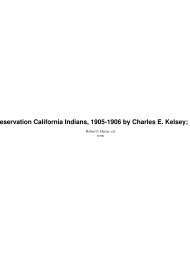YA summer '01 - Yosemite Online
YA summer '01 - Yosemite Online
YA summer '01 - Yosemite Online
You also want an ePaper? Increase the reach of your titles
YUMPU automatically turns print PDFs into web optimized ePapers that Google loves.
Figure 6. The Lyell Fork of the Tuolumne River above Tuolumne<br />
Meadows. Note the gentle, sweeping curves of this broadly U-<br />
shaped glaciated valley. Photograph by Robert W. Cameron. ©<br />
Cameron and Company; used with permission.<br />
that river’s large drainage basin, 2-1/2 times the size of<br />
the one feeding ice to <strong>Yosemite</strong> Valley, many high-valley<br />
glaciers converged and completely filled Hetch Hetchy<br />
Valley, leaving lateral moraines thousands of feet above<br />
the valley floor. 3 Hetch Hetchy’s walls are relatively clean,<br />
accentuating its classic U-shaped character. The valley<br />
has little talus because successive glaciers removed weak<br />
and weathered rock from the cliffs and rockfall debris<br />
from the valley floor.<br />
<strong>Yosemite</strong> Valley’s glacial history is quite different. The<br />
huge Sherwin glacier of one million years ago excavated<br />
the valley and overtopped its walls, but since that time<br />
no glaciers have completely filled the valley. The last and<br />
much smaller Tioga-age glacier scoured the lower parts<br />
of valley walls part way down the valley and skimmed off<br />
talus and some valley fill, leaving the Bridalveil terminal<br />
moraine and El Capitan recessional moraine in its wake. 4<br />
As a result, over the last million years, the rock of the<br />
upper valley walls has weathered, joints have been<br />
enlarged, and rock has spalled off to form an irregularly<br />
sculptured surface, including the pinnacles and spires<br />
that we see today. With its angled, weathered walls and<br />
large talus accumulations, <strong>Yosemite</strong> Valley has lost much<br />
of the cleaner U-shape character that it might have once<br />
had. Because of post-glacial valley fill, its U-shape may<br />
actually have been visually enhanced. What <strong>Yosemite</strong><br />
Valley has lost is the smooth, linear valley walls that are<br />
now sharply angled and deeply weathered.<br />
John Muir glossed over these differences between<br />
Hetch Hetchy and <strong>Yosemite</strong> Valley. Calling all similar<br />
glaciated Sierran valleys, including Kings Canyon,<br />
“yosemites” as a generic term, he wrote that “Nature is<br />
not so poor as to possess only one of anything.” 5<br />
At the same time, these differences puzzled Josiah<br />
Whitney who could see the evidence for an extensive glacier<br />
in Hetch Hetchy, but could not visualize effective<br />
glaciation in <strong>Yosemite</strong> Valley. He wrote: “The walls of the<br />
<strong>Yosemite</strong> on each side were carefully examined by the<br />
writer without his having been able to find on them any<br />
signs of smoothed, striated, or polished surfaces which<br />
could be unhesitatingly set down as the work of ice.” 6<br />
Muir helped define and emphasize the erosive power<br />
of ice; Whitney was more receptive to the erosive power of<br />
water. Both were grappling with the problem of the origins<br />
of U- and V-shaped valleys. Since their time we have<br />
learned that mountains are sculptured not just by water,<br />
not just by ice, but over time by both in combination with<br />
other complex forces and conditions so striking that their<br />
results have been set aside as <strong>Yosemite</strong> National Park.<br />
ACKNOWLEDGMENTS<br />
This article draws on material compiled by my colleague,<br />
the late Clyde Wahrhaftig, for his geology classes at<br />
University of California, Berkeley. I am also deeply<br />
indebted to James B. Snyder, <strong>Yosemite</strong> Park Historian, for<br />
assistance in the historical aspects of this presentation.<br />
FOOTNOTES<br />
1. G. I. Smith, V. J. Barczak, G. F. Moulton, and J. C. Liddicoat,<br />
Core KM-3, a Surface-to-Bedrock Record of Late Cenozoic<br />
Sedimentation in Searles Valley, California (U. S. Geological<br />
Survey Professional Paper 1256 [1983], p. 22).<br />
2. For a mathematical derivation of this measure of erosive<br />
force see: Arvid M. Johnson, Physical Processes in Geology (San<br />
Francisco, CA, Freeman, Cooper & Company [1970]).<br />
3. T. R. Alpha, Clyde Wahrhaftig, and N. K. Huber, Oblique Map<br />
Showing Maximum Extent of 20,000-Year-Old (Tioga) Glaciers,<br />
<strong>Yosemite</strong> National Park, Central Sierra Nevada, California (U. S.<br />
Geological Survey Miscellaneous Investigations Series Map I-<br />
1885 [1987]).<br />
4. N. K. Huber and J. B. Snyder, A History of the El Capitan<br />
Moraine (<strong>Yosemite</strong> Association, <strong>Yosemite</strong>, v. 64, no. 1 [2002], p.<br />
2-6).<br />
5. John Muir, Studies in the Sierra—Origin of <strong>Yosemite</strong> Valleys<br />
(Overland Monthly, June 1874, p.496).<br />
6. J. D. Whitney, The Climatic Changes of Later Geological<br />
Times: A Discussion Based on Observations Made in the<br />
Cordilleras of North America (Cambridge, MA: University Press,<br />
[1880]).<br />
N. King Huber is Geologist Emeritus with the U.S.<br />
Geological Survey. The author of The Geologic<br />
Story of <strong>Yosemite</strong> National Park, he is a regular<br />
contributor to this journal.<br />
8 YOSEMITE ASSOCIATION, FALL 2003




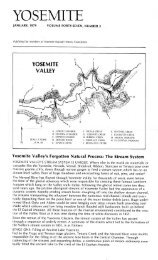
![(March 1982) [PDF] “We Are Pleased to Announce†- Yosemite Online](https://img.yumpu.com/51299748/1/190x242/march-1982-pdf-aeuroewe-are-pleased-to-announceaeur-yosemite-online.jpg?quality=85)
![[PDF] Old Horny, Yosemite's Unicorn Buck - Yosemite Online](https://img.yumpu.com/51269869/1/184x260/pdf-old-horny-yosemites-unicorn-buck-yosemite-online.jpg?quality=85)
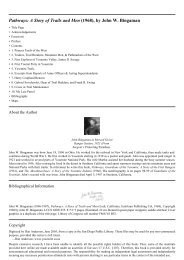
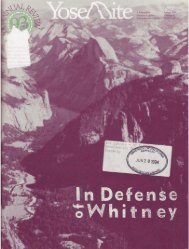
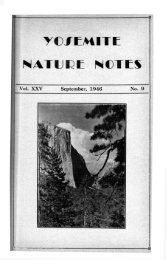
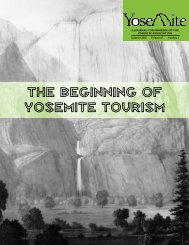
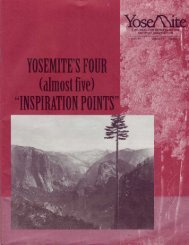
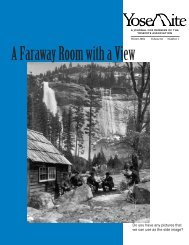
![1985 [PDF] - Yosemite](https://img.yumpu.com/48128837/1/184x260/1985-pdf-yosemite.jpg?quality=85)

